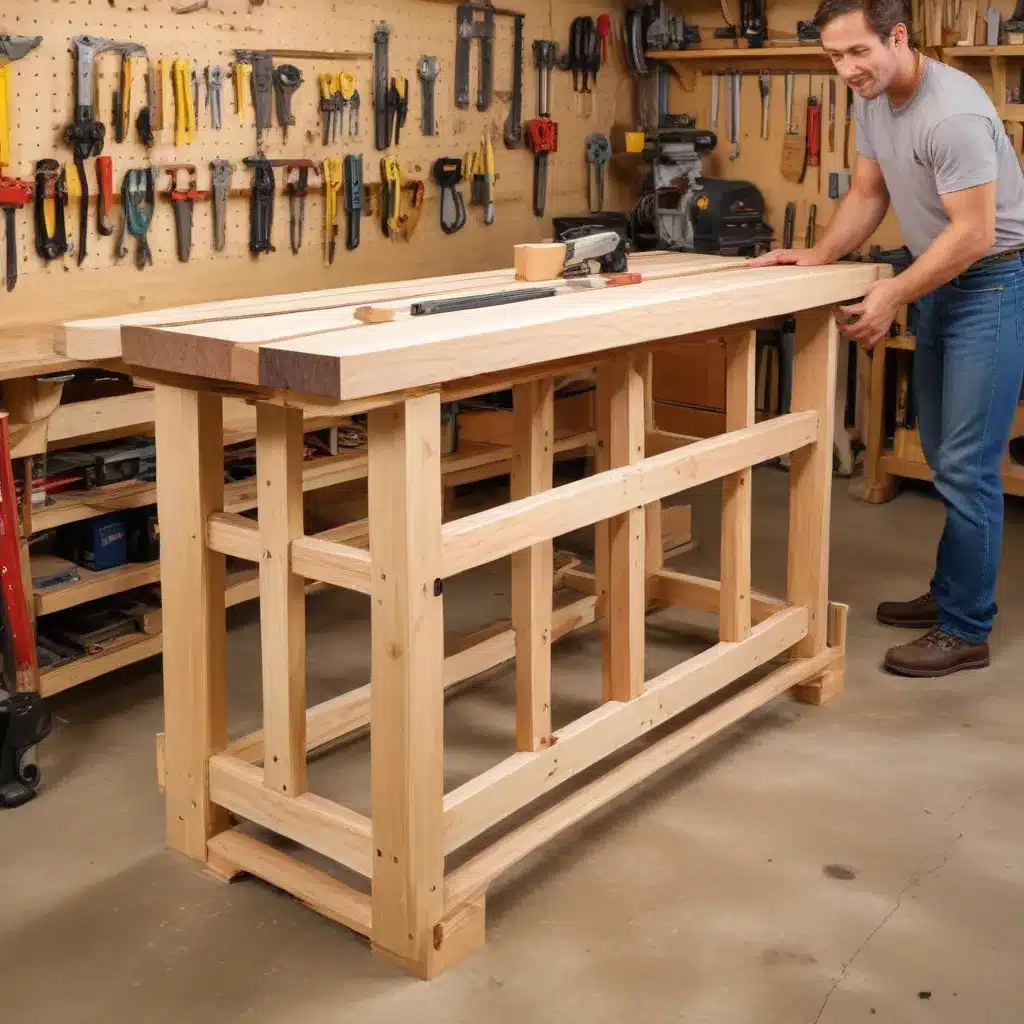
As an experienced woodworker, I’ve spent countless hours perfecting my craft and honing my skills. One of the most important aspects of any woodworking endeavor is the workbench – the foundation upon which all of our projects are built. A well-designed, sturdy, and versatile workbench can make all the difference in the quality and efficiency of our work.
Choosing the Right Workbench for Your Needs
When it comes to selecting a workbench, there’s no one-size-fits-all solution. The ideal workbench will depend on the type of projects you typically undertake, the space you have available in your workshop, and your personal preferences. Let’s explore some of the key considerations:
Workbench Size and Dimensions
The size of your workbench is crucial, as it will determine the scale and complexity of the projects you can tackle. A larger workbench will provide more surface area and accommodate larger pieces of wood, while a smaller bench may be better suited for intricate or delicate work. Consider the dimensions of your workshop and the types of projects you plan to work on to find the right balance.
Workbench Construction and Materials
The materials used in the construction of your workbench can greatly impact its durability, stability, and performance. Traditional woodworking benches are often made from solid hardwood, such as beech or maple, which offer exceptional strength and longevity. More modern designs may incorporate a combination of wood, metal, and even composites for added versatility and ease of use.
Workbench Features and Accessories
Workbenches can come with a variety of features and accessories that can enhance their functionality. Look for benches with built-in vises, dog holes, and clamping systems, as these can greatly facilitate the clamping and securing of your workpieces. Some workbenches also offer adjustable heights, allowing you to customize the workspace to your specific needs.
Mastering Workbench Ergonomics
Proper ergonomics are essential for maintaining comfort and avoiding fatigue during long woodworking sessions. Consider the height of your workbench and ensure that it’s aligned with your natural standing posture. A workbench that’s too low can lead to back strain, while one that’s too high can cause shoulder and neck discomfort.
Another important factor is the placement of your tools and materials. Organize your workspace in a way that minimizes unnecessary movement and maximizes efficiency. Keep frequently used items within easy reach, and consider incorporating storage solutions, such as drawers or shelves, to keep your workspace tidy and uncluttered.
Maintaining Your Workbench
A well-maintained workbench is crucial for ensuring the longevity and performance of your investment. Regularly clean and oil the surface to prevent the buildup of debris and protect the wood from moisture and wear. Inspect the workbench’s structural components, such as the legs and joints, and make any necessary adjustments or repairs to maintain its stability and strength.
If you’re working with a wooden workbench, consider applying a protective finish, such as a hard wax or oil-based sealant, to further enhance its durability and resistance to damage. This will not only extend the life of your workbench but also make it easier to clean and maintain over time.
Woodworking Techniques and Tools
Now that we’ve covered the fundamentals of choosing and maintaining a workbench, let’s delve into the world of woodworking techniques and tools. As a seasoned woodworker, I’ve had the opportunity to experiment with a wide range of tools and methods, and I’m excited to share some of my insights with you.
Mastering Hand Tools
While power tools have become increasingly popular in modern woodworking, hand tools still play a crucial role in the craft. Investing in high-quality hand tools, such as chisels, planes, and saws, can greatly enhance the precision and control you have over your projects. Take the time to learn proper sharpening and maintenance techniques to ensure your hand tools remain in top condition.
Leveraging Power Tools Effectively
Power tools can greatly increase the efficiency and speed of your woodworking projects, but it’s important to use them with caution and proper safety protocols. Familiarize yourself with the operation and safety features of each tool, and always wear the appropriate personal protective equipment (PPE) when using power tools.
Experimenting with Finishing Techniques
The final touch on any woodworking project is the finishing process. Explore a variety of finishing techniques, such as staining, varnishing, and lacquering, to achieve the desired aesthetic and protective qualities for your projects. Pay close attention to the drying times, application methods, and safety precautions associated with each finishing technique.
Embracing Sustainable Woodworking Practices
As we become more conscious of our environmental impact, it’s important to consider incorporating sustainable practices into our woodworking routines. This can include sourcing eco-friendly materials, minimizing waste, and exploring renewable energy sources for your workshop.
One effective way to reduce waste is to carefully plan your projects and optimize the use of your materials. Consider incorporating techniques like intarsia or marquetry to create stunning designs while minimizing material consumption. Additionally, explore options for repurposing or recycling any leftover wood scraps, ensuring that your woodworking endeavors align with your environmental values.
Conclusion
Crafting the perfect woodworking workbench is an ongoing journey, one that requires a keen eye for detail, a deep understanding of your tools and materials, and a commitment to continuous learning and improvement. By carefully selecting the right workbench for your needs, optimizing your workspace ergonomics, and maintaining your tools and equipment, you’ll be well on your way to creating stunning, high-quality woodworking projects that showcase your expertise and passion.
Remember, as a woodworker, you’re not just shaping wood – you’re shaping the very fabric of your craft. I encourage you to explore woodcraftparts.net for a wide range of high-quality woodworking supplies and resources to help you elevate your skills and take your projects to new heights. Happy crafting!

